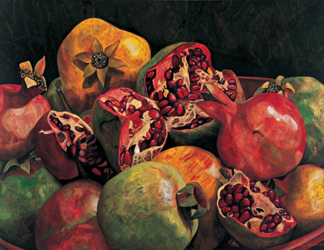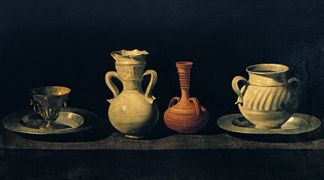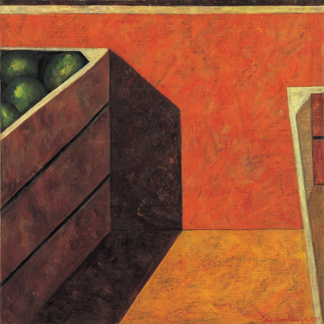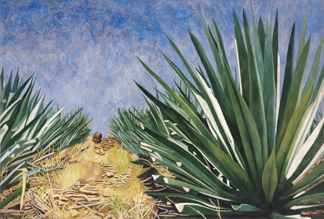Published 05/08/2011

One would assume Mexican artist Pedro Diego Alvarado would feel an almost certain pressure. After all his grandfather is Diego Rivera, an artistic heavyweight of almost mythical proportions. Instead, Alvarado feels proud to be considered a successor to The Mexican School which includes, in addition to his grandfather, artists such as Jose Clemente Orozco and Rufino Tamayo. Although Alvarado's paintings differ from his ascendants nationalistic narratives, his work comprising mainly the natural and ancient world is no less a statement of love and respect for his native land. According to art critic, Dr. Solomon Grimberg, Alvarado's works are perhaps better understood in the context of three female Mexican artists: Frida Kahlo, Maria Izquierdo and Olga Donde, whose paintings all made a 'radical contribution' to the still life genre. His depictions of the landscapes and the native flora and fauna of Mexico, are at once ancient and modern, fleeting and timeless. Bridgeman is proud to represent these works by Pedro Diego Alvarado, for licensing.
Recently, we spoke with the artist and asked him a few questions.
|
BAL: Of all your incredible opportunities to work with the likes of Henri Cartier-Bresson, and a variety of Central American artists including Ricardo Martinez, Jesus Gallardo and Armando Morales, which studio was most essential for your development as an artist? PDA: With Henri Cartier-Bresson I learned how to draw, in Ricardo Martinez's studio, I painted my first oil paintings and with Armando Morales, I developed my personal way of painting. All three periods were essentially important for me, I couldn't choose one. |
BAL: What was your favorite piece of advice you ever received about painting, and from whom? PDA: At the beginning of my career, I read a letter that Henri Matisse wrote to Henry Clifford, at that time the director of the Philadelphia Museum of Art, as he was organizing a big Matisse exhibition for the museum. Matisse was worried about the more or less disastrous influence of his show on the young painters, how the apparent facility of his work could lead young painters to avoid the slow and painful preparation to any contemporary painter who pretends to build a painting with colors....Matisse felt that the slow and painful work was indispensable. This letter became, for me, the best advice. |
|
| BAL: You speak a lot about being influenced by Renaissance artists and their intense study of the craft of painting. Is there a particular artist or painting of that period that sparked this interest? PDA: A long time ago I saw two still lifes by Francisco de Zurbaran. During many museum visits, I was exposed to Flemish art and paintings by Vermeer, Tintoretto and Tiziano. It astonished me that, nowadays, nobody is able to paint with such a richness of craft. |
BAL: How would you describe your artistic language? PDA: I always work from nature, landscapes or still lifes, I would name it Naturalistic.
BAL: In your work, light is an essential qualities. Is there a particular time of day where the light inspires you? PDA: I like strong light and shadow, as it is the light of Mexico, but the end of the day inspires me a lot.
BAL: Do you ever get obsessed with particular paintings or external factors that influence your craft? PDA: The only thing that obsesses me is solving the problems that are part of the paintings I am working on, everything else is part of life. |
|
|
BAL: Any thoughts on contemporary Mexican art? PDA: I'll talk about painting, not 'contemporary art' which usually is not painting. Doubtless the greatest is Francisco Toledo. Also, from the generation after The Mexican School, there are great painters like Vincente Rojo and Felguerez. From my generation, there are also very good painters: Francisco Castro Lenero, Irma Palacios, Sergio Hernandez, Macotela, Ricardo Mazal, Juan Torres, Rafael Cauduro, Nahum Zenil and Silvia Ordonez, to name a few. |
In an interview with Chile's Paula Magazine in 2001, Alvarado explained what it meant to be a Mexican painter,
"In Mexico we have extraordinary light...we live surrounded by very lively colors and that reality is necessarily reflected in my work. I am a Mexican painter, not only by birth but also because I live and work here. The great Mexican painters (Orozco, Rivera, Tamayo) reflected this light, the biodiversity, the fruits, the men and their cultures in their creations...These are all very profound things and are a part of what it is to be Mexican."
What's next for Pedro Diego? His work will be exhibited at a one man show at the Arte Actual Mexicano gallery in Monterrey, Nuevo Leon starting in March 2012. In November 2012, his work will be featured in a museum show curated by Dr. Solomon Grimberg at the Museo de San Indefonso in Mexico City.







